Classical proportion follows the harmonious balance found in nature and art, often guided by the golden ratio to achieve aesthetic appeal. This principle ensures that elements within a design relate to each other with pleasing symmetry and visual order. Explore the rest of the article to discover how mastering classical proportion can elevate your creative projects.
Table of Comparison
| Aspect | Classical Proportion | Mannerist Distortion |
|---|---|---|
| Definition | Balanced and harmonious ratios based on mathematical ideals | Exaggerated and elongated forms breaking traditional rules |
| Examples | Leonardo da Vinci's "Vitruvian Man", Raphael's "School of Athens" | El Greco's elongated figures, Pontormo's twisted poses |
| Focus | Symmetry, naturalism, and ideal beauty | Expressiveness, tension, and emotional impact |
| Technique | Clear perspective, proportional anatomy | Distorted anatomy, unusual perspectives |
| Art Period | Renaissance (15th-16th century) | Mannerism (16th century) |
Introduction to Classical Proportion
Classical proportion is grounded in mathematical ratios derived from ancient Greek and Roman art, emphasizing harmony, balance, and idealized human forms. This system uses precise measurements such as the Vitruvian principles and the Golden Ratio to create visually pleasing and structurally stable compositions. Mastery of classical proportion ensures anatomical accuracy and symmetry, establishing a foundation for the evolution of later artistic styles like Mannerism.
Defining the Mannerist Approach
The Mannerist approach subverts classical proportion by deliberately elongating and exaggerating human forms to evoke tension and emotion, contrasting the balanced harmony and idealized symmetry characteristic of Renaissance art. Artists like Parmigianino and Pontormo emphasize artificiality and ambiguous spatial relationships, creating compositions that challenge viewers' expectations of naturalistic representation. This stylistic distortion reflects the intellectual complexity and emotional intensity of the late 16th century, marking a shift from the rational clarity of classical ideals to expressive, sophisticated manipulation of form.
Historical Origins of Classical Proportion
Classical proportion originated in ancient Greek and Roman architecture, emphasizing harmony, balance, and mathematical ratios such as the Golden Ratio to achieve aesthetic perfection. Architects like Vitruvius codified these principles in works like "De Architectura," which became foundational for Renaissance art and architecture. This system of proportion was designed to reflect natural order and human scale, contrasting with the later Mannerist distortion that intentionally exaggerated forms for dramatic effect.
Emergence of Mannerist Distortion
Mannerist Distortion emerged in the early 16th century as a reaction against the harmonious balance and idealized forms of Classical Proportion characteristic of the High Renaissance. Artists like El Greco and Pontormo manipulated scale, elongated limbs, and complex poses to evoke emotional intensity and tension rather than naturalistic accuracy. This stylistic shift marked a move toward expressive complexity, challenging the rigid symmetry and rationality that defined Classical art.
Key Artists: Classical vs Mannerist
Classical proportion, exemplified by artists such as Leonardo da Vinci and Raphael, emphasizes balanced symmetry and idealized human anatomy based on mathematical ratios like the Golden Ratio. In contrast, key Mannerist artists including Pontormo, Parmigianino, and El Greco distort proportions deliberately, elongating limbs and twisting poses to evoke tension and emotion. These divergent approaches highlight the Classical pursuit of harmony versus the Mannerist focus on expressive exaggeration and complexity.
Aesthetic Principles and Philosophies
Classical proportion emphasizes harmony, balance, and idealized human forms based on mathematical ratios derived from nature, reflecting Renaissance ideals of order and beauty. Mannerist distortion intentionally exaggerates proportions and poses to evoke tension, emotion, and complexity, challenging the symmetry and calm of classical aesthetics. These contrasting philosophies represent a shift from measured perfection to expressive dynamism in art and design.
Visual Analysis: Harmony vs Exaggeration
Classical proportion relies on mathematical ratios and symmetry to create visual harmony and balance, emphasizing idealized human forms and spatial coherence. Mannerist distortion intentionally exaggerates body parts and elongates figures to evoke tension and emotional intensity, disrupting naturalistic representation. The contrast between harmony and exaggeration highlights differing artistic intentions: Classical art seeks order and beauty, while Mannerism prioritizes expressive drama and complexity.
Impact on Art and Architecture
Classical proportion emphasizes harmony, balance, and mathematical precision, influencing Renaissance art and architecture with structures exhibiting symmetrical form and ideal human anatomy, as seen in the works of Leonardo da Vinci and Palladio. In contrast, Mannerist distortion challenges these norms by exaggerating figures, elongating limbs, and creating tension-filled compositions, which introduced emotional complexity and dynamic movement, evident in paintings by Pontormo and architecture by Giulio Romano. The impact on art and architecture includes a shift from ordered beauty to expressive, sometimes unsettling aesthetics that paved the way for Baroque dramatic intensity.
Legacy in Modern Artistic Styles
Classical Proportion, rooted in Renaissance ideals, emphasizes harmony and mathematical precision, influencing neoclassical and academic art with its balanced forms and accurate anatomy. Mannerist Distortion introduced exaggerated poses and elongated figures, challenging traditional aesthetics and inspiring modern movements like Expressionism and Surrealism with its emotional intensity and abstraction. The legacy of these contrasting approaches endures in contemporary art through ongoing explorations of form, proportion, and expressive exaggeration.
Conclusion: Balancing Tradition and Innovation
Classical proportion emphasizes harmony and mathematical precision, rooted in Renaissance ideals of balance and order, while Mannerist distortion challenges these conventions by exaggerating forms and introducing dynamic tension. Balancing tradition and innovation involves integrating the structured symmetry of classical art with the expressive freedom of mannerism, creating works that respect historical principles while embracing creative exploration. This fusion allows artists to push boundaries without abandoning the foundational aesthetics that define classical beauty.
Classical Proportion Infographic

 libterm.com
libterm.com